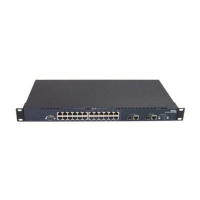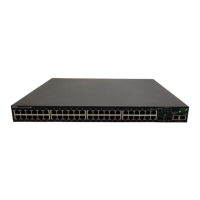598 BigIron RX Series Configuration Guide
53-1002253-01
PIM dense
23
Multicast protocols can only be applied to 1 physical interface. You must create multiple VLANs with
individual untagged ports and ve’s under which you configure PIM.
PIM was introduced to simplify some of the complexity of the routing protocol at the cost of
additional overhead tied with a greater replication of forwarded multicast packets. PIM is similar to
DVMRP in that PIM builds source-routed multicast delivery trees and employs reverse path check
when forwarding multicast packets.
There are two modes in which PIM operates: Dense and Sparse. The Dense Mode is suitable for
densely populated multicast groups, primarily in the LAN environment. The Sparse Mode is suitable
for sparsely populated multicast groups with the focus on WAN.
PIM primarily differs from DVMRP by using the IP routing table instead of maintaining its own,
thereby being routing protocol independent.
Initiating PIM multicasts on a network
Once PIM is enabled on each router, a network user can begin a video conference multicast from
the server on R1 as shown in Figure 90. When a multicast packet is received on a PIM-capable
router interface, the interface checks its IP routing table to determine whether the interface that
received the message provides the shortest path back to the source. If the interface does provide
the shortest path back to the source, the multicast packet is then forwarded to all neighboring PIM
routers. Otherwise, the multicast packet is discarded and a prune message is sent back upstream.
In Figure 90, the root node (R1) is forwarding multicast packets for group 229.225.0.1, which it
receives from the server, to its downstream nodes, R2, R3, and R4. Router R4 is an intermediate
router with R5 and R6 as its downstream routers. Because R5 and R6 have no downstream
interfaces, they are leaf nodes. The receivers in this example are those workstations that are
resident on routers R2, R3, and R6.
Pruning a multicast tree
As multicast packets reach these leaf routers, the routers check their IGMP databases for the
group. If the group is not in a router’s IGMP database, the router discards the packet and sends a
prune message to the upstream router. The router that discarded the packet also maintains the
prune state for the source, group (S,G) pair. The branch is then pruned (removed) from the
multicast tree. No further multicast packets for that specific (S,G) pair will be received from that
upstream router until the prune state expires. You can configure the PIM Prune Timer (the length of
time that a prune state is considered valid).
For example, in Figure 90 the sender with address 207.95.5.1 is sending multicast packets to the
group 229.225.0.1. If a PIM router receives any groups other than that group, the router discards
the group and sends a prune message to the upstream PIM router.
In Figure 91, Router R5 is a leaf node with no group members in its IGMP database. Therefore, the
router must be pruned from the multicast tree. R5 sends a prune message upstream to its
neighbor router R4 to remove itself from the multicast delivery tree and install a prune state, as
seen in Figure 91. Router 5 will not receive any further multicast traffic until the prune age interval
expires.

